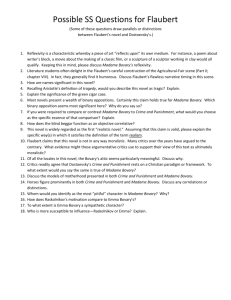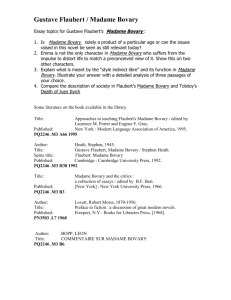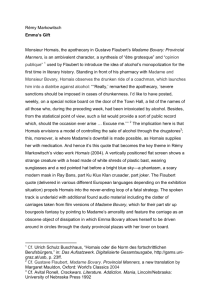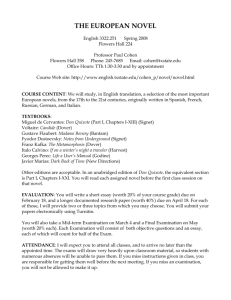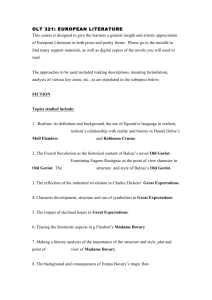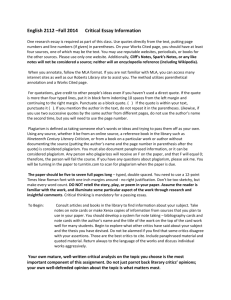Madame Bovary - Free Teacher Resources
advertisement
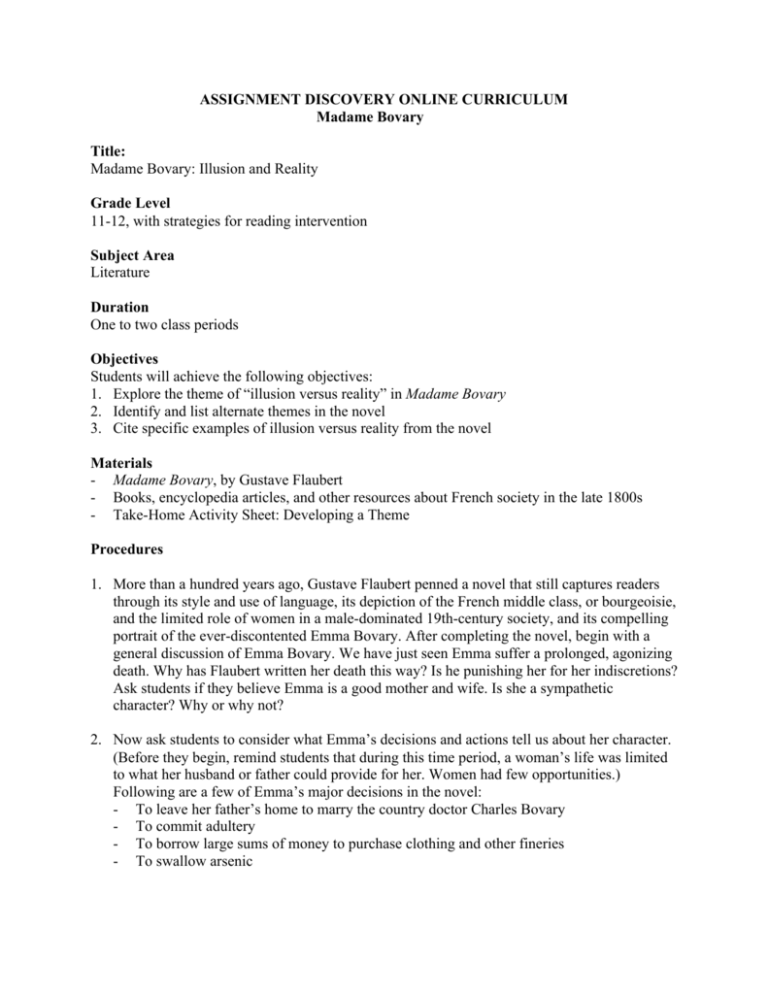
ASSIGNMENT DISCOVERY ONLINE CURRICULUM Madame Bovary Title: Madame Bovary: Illusion and Reality Grade Level 11-12, with strategies for reading intervention Subject Area Literature Duration One to two class periods Objectives Students will achieve the following objectives: 1. Explore the theme of “illusion versus reality” in Madame Bovary 2. Identify and list alternate themes in the novel 3. Cite specific examples of illusion versus reality from the novel Materials - Madame Bovary, by Gustave Flaubert - Books, encyclopedia articles, and other resources about French society in the late 1800s - Take-Home Activity Sheet: Developing a Theme Procedures 1. More than a hundred years ago, Gustave Flaubert penned a novel that still captures readers through its style and use of language, its depiction of the French middle class, or bourgeoisie, and the limited role of women in a male-dominated 19th-century society, and its compelling portrait of the ever-discontented Emma Bovary. After completing the novel, begin with a general discussion of Emma Bovary. We have just seen Emma suffer a prolonged, agonizing death. Why has Flaubert written her death this way? Is he punishing her for her indiscretions? Ask students if they believe Emma is a good mother and wife. Is she a sympathetic character? Why or why not? 2. Now ask students to consider what Emma’s decisions and actions tell us about her character. (Before they begin, remind students that during this time period, a woman’s life was limited to what her husband or father could provide for her. Women had few opportunities.) Following are a few of Emma’s major decisions in the novel: - To leave her father’s home to marry the country doctor Charles Bovary - To commit adultery - To borrow large sums of money to purchase clothing and other fineries - To swallow arsenic 3. Ask students to brainstorm major themes of the novel. (Remind students that a theme is a recurrent idea that is woven throughout the story and that novels can easily have more than one theme.) Some themes to look for include romanticism, the materialism of the French bourgeoisie, and the limitations of a woman’s life in the 19th century. Explain that one of the major themes of the novel could be described as “illusion versus reality.” Ask students to describe how that theme is reflected in the novel. For example, many of the characters live in a world of illusion, blind to the realities that surround them. 4. Ask students to brainstorm examples of the illusion versus reality theme in the novel. Draw a T-chart on the chalkboard with the word illusion in one column and reality in the other. Under illusion, have students cite examples from the novel that show the illusions of Emma and other characters. In the reality column, have them explain the reality behind that illusion. Here are some examples: Illusion Emma spends money extravagantly, as if it’s unlimited. Emma believes that adultery will free her from the confines of her marriage. Emma believes the poison she takes to end her life will not cause her great pain. She expects to swoon and die gracefully, as characters do in her novels. Charles is content, believing he and Emma are happily married. Reality The Bovarys have been teetering on the edge of bankruptcy because of Emma’s uncontrolled expenditures. She fails to recognize that upon each new conquest, she is once again bored and unfulfilled. After taking the poison, Emma falls severely ill and suffers great pain. Charles is blind to Emma’s adultery. The bourgeoisie, or French middle class, appear to have everything. From Flaubert’s description, it seems this society has no spiritual or emotional depth. Homais is awarded the Legion of Honor and is seen as a great man. Flaubert depicts Homais as a simpering, self-important deceiver. 5. After completing the T-chart with students, make sure students have copied the information they have gathered on the chalkboard into their notebooks. 6. For homework, hand out copies of the Take-Home Activity Sheet: Developing a Theme. Have students give one example of a character’s illusion in the novel, along with the reality behind that illusion. They can choose one from those discussed in class, but encourage them to select a new example from the novel. Then have them find two quotations from the novel—one that shows the illusion and a second that describes the reality. Adaptation As a reading intervention strategy, discuss examples of illusion versus reality as a class. Then divide the class into small groups and have each group find an example from the novel that shows how Emma lives in a world of illusion. Each group should find two quotations—one showing Emma’s illusion and a second that reflects the reality of Emma’s world. Questions 1. What do you think would have made Madame Bovary happy with her life? 2. A “tragic” novel is one in which the main character is brought to ruin or suffers extreme sorrow, especially as a consequence of a “tragic flaw,” a moral weakness, or an inability to cope with difficult circumstances. Could the novel Madame Bovary be considered a tragic novel? Why or why not? 3. How did the conservative social mores of the time play a role in the downfall of Madame Bovary? 4. If Madame Bovary were set in America in the 20th century, how would it be like the original novel? How might it be different? 5. How did Madame Bovary’s romantic sentiment contribute to her life of discontent and ruin? 6. What is your opinion of how Flaubert treats the male characters? Do you think he portrays them realistically? Explain your answer. Evaluation You can evaluate your students on the in-class discussion of illusion versus reality and the completion of their activity sheets using the following three-point rubric: Three points: contributed specific examples to the class discussion; provided an example of illusion versus reality different from those discussed in class; found relevant textual citations for the activity sheet Two points: contributed at least one example to the class discussion; provided at least one relevant textual citation for the activity sheet One point: did not contribute to the class discussion; textual citations on the activity sheet are not relevant and do not support the illusion versus reality theme Extensions Madame Bovary at the Ball Remind students that one of Madame Bovary’s happiest moments occurs when she attends a grand ball. Ask students to research what an elegant event such as the ball was like in the 1850s. Encourage students to research the dress, manners, food, music, and dances of that period. They may create a multimedia presentation, an illustrated report, or a Web site. Whichever form they choose, challenge students to include details from the period, such as recorded music, samples of the food that was served, or pictures of the formal dress. Allow time for students to present their documentaries to the class. Exploring Irony Irony is a literary device characterized by a deliberate contrast between what is expected to happen to a character and the actual outcome. Flaubert’s use of irony contributes to the character development of Madame Bovary and other characters in the novel, and it also adds a bitter twist to the novel’s tragic ending. Ask students to reread Emma Bovary’s death scene and find one quotation that is an example of irony. Have students explain what is happening in the passage they have chosen and why they consider it to be an example of irony. Students should share their examples in a class discussion and consider what insights these little ironies give us into the characters. For example, a student may choose the following quote from Emma’s death scene. It is from book 3, chapter 8, where Emma first begins to feel the effects of the poison she has taken, while Charles is at her bedside: “God!” she cried. “It’s horrible!” He flung himself on his knees beside her bed. “Speak to me! What did you eat? Answer, for heaven’s sake!” And in his eyes she read a love such as she had never known. The passage is ironic because Emma, and perhaps the reader, had not realized that her husband was capable of such feeling. Emma has spent the novel searching for love, only to realize on her deathbed that her husband, for all his faults, always loved her. Suggested Readings: Women in 19th Century America Fiona Macdonald, Peter Bedrick Books, 1999. Society's ideal view of women in the United States during the 19th century was often very different from reality. This book examines what everyday life was really like for many women. Period illustrations and photographs, quotes from women of the time, and brief biographies of famous women of the century enrich the book. Searching for Emma: Gustave Flaubert and Madame Bovary Dacia Maraini, The University of Chicago Press, 1998. Written in an engaging, almost conversational tone, this book is nevertheless a serious examination of the relationship between the author Flaubert, the women in his life, and Emma, the main character he creates in Madame Bovary. Throughout the book, Maraini interweaves insights about the character Flaubert created with discussions of the author's life and his attitude toward women. Web Links: IPL Online Library The site offers a few links to literary criticism about MADAME BOVARY and biographical information about the author. http://www.ipl.org/ref/litcrit/ Madame Bovary This is an AP literature class created site which includes interesting material about the author, the French world reflected in the novel, and the controversy and trial surrounding the novel. It is extremely accessible to students, and appears to be well edited and well researched. http://www.springfield.k12.il.us/schools/southeast/bovary/index.html Britannica.com-Flaubert This main Flaubert page provides a link to a discussion of the novel and articles about MADAME BOVARY pertinent to this lesson, such as characters, setting, and literary realism. http://search.britannica.com/search?query=flaubert Vocabulary adultery Definition: A sexual romance between a married person and someone other than the person’s wife or husband. Context: Charles Bovary only found out about his wife’s adultery when he discovered Emma’s love letters. bourgeois Definition: Relating to the social middle class marked by a concern for material interests and respectability and a tendency toward mediocrity. Context: Emma Bovary was not satisfied to be a member of the bourgeois class but instead would have preferred to be a member of the aristocracy. duplicitous Definition: The belying of one’s true intentions by deceptive words or actions. Context: Emma’s duplicitous nature was never more evident than when she lied about taking music lessons. infidelity Definition: Marital unfaithfulness or an act of unfaithfulness. Context: Charles Bovary always thought Emma was faithful to him; he was never aware of his wife’s infidelity. romanticism Definition: A literary, artistic, and philosophical movement originating in the 18th century, characterized by an emphasis on the imagination and emotions. Context: Flaubert’s novel Madame Bovary is a classic example of romanticism in literature. Academic standards This program may be used to address the following academic standards, which are based on national standards put forth by the NCTM, NCTE, NSTA, and many others. Grade level: 9-12 Subject area: Literature Standard: Uses reading skills and strategies to understand and interpret a variety of literary texts. Benchmark: Analyzes the simple and complex actions (e.g., internal/external conflicts) between main and subordinate characters in literary works containing complex character structures. Grade level: 9-12 Subject area: Literature Standard: Uses reading skills and strategies to understand and interpret a variety of literary texts. Benchmark: Understands relationships between literature and its historical period, culture, and society (e.g., influence of historical context on form, style, and point of view; influence of literature on political events; social influences on an author’s description of characters, plot, and setting; how writers represent and reveal their cultures and traditions). Grade level: 9-12 Subject area: Literature Standard: Uses reading skills and strategies to understand and interpret a variety of literary texts. Benchmark: Uses language and perspectives of literary criticism to evaluate literary works (e.g., evaluates aesthetic qualities of style, such as diction, tone, theme, mood; identifies ambiguities, subtleties, and incongruities in the text; compares reviews of literature, film, and performances with own response). Credit Audrey Carangelo, freelance curriculum developer. DiscoverySchool.com http://www.discoveryschool.com Copyright 2000 Discovery.com. Teachers may reproduce copies of these materials for classroom use only. Take-Home Activity Sheet: Madame Bovary: Illusion and Reality Name: Developing a Theme In class, you discussed examples of the “illusion versus reality” theme from the novel Madame Bovary. In the chart below, give one example of a character’s illusion in the novel, along with the reality behind that illusion. (If you can’t come up with a new example, you can use one discussed in class.) Then find two textual citations from the novel: one that reflects the illusion and a second that shows the reality. Be sure to give the chapter and page number of your citation. Illusion Reality Description: Description: Textual citation: Textual citation:
